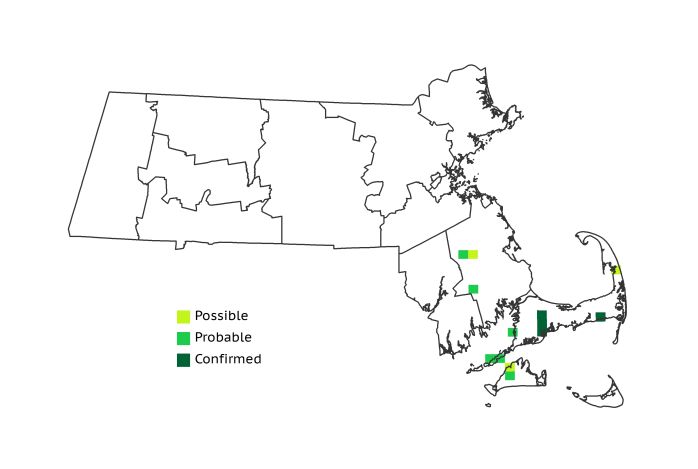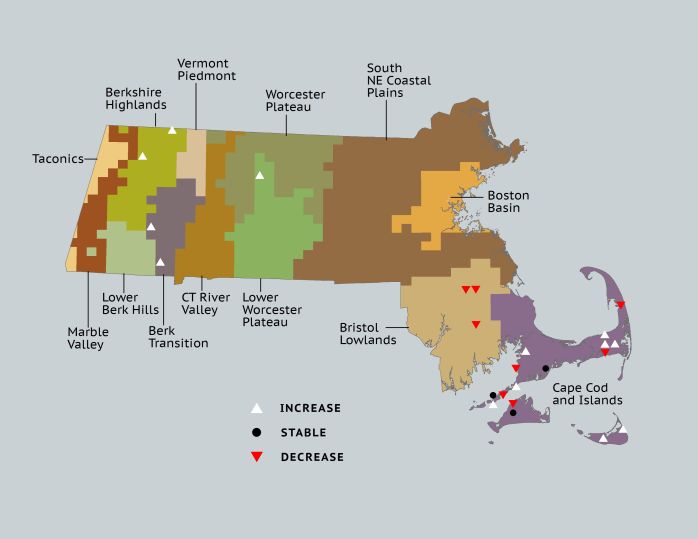Find a Bird
Northern Parula
Parula americana

Local and strongly increasing
Threatened Species
“There was an Old Man with a beard / Who said, ‘It is just as I feared! / Two Owls and a Hen / Four Larks and a Wren / Have all built their nests in my beard.’” – Edward Lear
The hanging lichens known as Old Man’s Beard (Usnea sp) may not be home to quite the aviary featured in the poem above, but the plant’s softness and antimicrobial properties make it a popular nesting material nonetheless. Perhaps no species takes better advantage of this unusual building material than the Northern Parula, whose nests in Massachusetts are constructed almost exclusively from the lichen in areas of wet forest (Petersen & Meservey 2003).
Historic Status
The Blue Yellow-backed Warbler, as the Northern Parula was once known, was never a common nester in Massachusetts. Reginald Heber Howe and Glover Morrill Allen wrote that it was a “common summer resident in localities where the Usnea lichen is found, particularly on Cape Cod, and Martha’s Vineyard,” (Howe & Allen 1901). As the presence of this lichen began to diminish during the early twentieth century, so, too, did nesting Northern Parulas.
Atlas 1 Distribution
The Northern Parula was quite restricted in its breeding distribution during Atlas 1, with only 13 occupied blocks and only 4 Confirmations statewide. Although a few Possible and Probable sites existed in the Bristol/Narragansett Lowlands, the only places that Northern Parulas were found nesting were in wet forests where there was an abundance of Old Man’s Beard lichen. The only such habitats with Confirmed breeding Northern Parulas were along the Mashpee River and in the wooded marshes of Harwich, both on the Cape and Islands. The presence of Northern Parulas in summer on Martha’s Vineyard and the Elizabeth Islands suggested that the full extent of the species’ breeding activities may have been slightly greater than evidenced, but in any case Northern Parulas were local breeders at best.
Atlas 2 Distribution and Change
The Usnea lichens on which this species depend are highly sensitive to airborne contaminants (Moldenhauer & Regelski 2012). The good news is that breeding Northern Parulas were detected in 28 blocks statewide, but most of these were Possible locations. Confirmations remained steady at 4. In the western part of the state there were numerous occasions when these warblers were found singing within the Safe Date period, but none persisted to breed, as demonstrated by the high number of Possible locations on the Atlas 2 maps. This vanguard of potentially prospecting birds could bode well for this species’ population growth in western Massachusetts. The Bristol/Narragansett Lowlands lost all 3 of its breeding Northern Parula blocks and gained no new ones, and the species was erratically present on the Cape and Islands.
Atlas 1 Map

Atlas 2 Map

Atlas Change Map

Ecoregion Data
Atlas 1 | Atlas 2 | Change | ||||||
Ecoregion | # Blocks | % Blocks | % of Range | # Blocks | % Blocks | % of Range | Change in # Blocks | Change in % Blocks |
Taconic Mountains | 0 | 0.0 | 0.0 | 0 | 0.0 | 0.0 | 0 | 0.0 |
Marble Valleys/Housatonic Valley | 0 | 0.0 | 0.0 | 0 | 0.0 | 0.0 | 0 | 0.0 |
Berkshire Highlands | 0 | 0.0 | 0.0 | 2 | 3.6 | 7.1 | 2 | 3.8 |
Lower Berkshire Hills | 0 | 0.0 | 0.0 | 0 | 0.0 | 0.0 | 0 | 0.0 |
Vermont Piedmont | 0 | 0.0 | 0.0 | 1 | 5.9 | 3.6 | 0 | 0.0 |
Berkshire Transition | 0 | 0.0 | 0.0 | 2 | 5.0 | 7.1 | 2 | 6.5 |
Connecticut River Valley | 0 | 0.0 | 0.0 | 1 | 1.5 | 3.6 | 0 | 0.0 |
Worcester Plateau | 0 | 0.0 | 0.0 | 4 | 4.5 | 14.3 | 0 | 0.0 |
Lower Worcester Plateau | 0 | 0.0 | 0.0 | 1 | 1.3 | 3.6 | 1 | 1.9 |
S. New England Coastal Plains and Hills | 0 | 0.0 | 0.0 | 1 | 0.4 | 3.6 | 0 | 0.0 |
Boston Basin | 0 | 0.0 | 0.0 | 0 | 0.0 | 0.0 | 0 | 0.0 |
Bristol and Narragansett Lowlands | 3 | 2.8 | 23.1 | 0 | 0.0 | 0.0 | -3 | -3.0 |
Cape Cod and Islands | 10 | 7.4 | 76.9 | 16 | 11.1 | 57.1 | 3 | 2.5 |
Statewide Total | 13 | 1.3 | 100.0 | 28 | 2.7 | 100.0 | 5 | 0.6 |
Notes
The Northern Parula shows a significant increasing Breeding Bird Survey trend in the New England/Mid-Atlantic Region and in the Eastern US overall.



